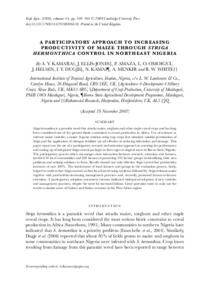| dc.contributor.author | Kamara, A.Y. |
| dc.contributor.author | Ellis-Jones, J. |
| dc.contributor.author | Amaza, P. |
| dc.contributor.author | Omoigui, L.O. |
| dc.contributor.author | Helsen, J. |
| dc.contributor.author | Dugje, I.Y. |
| dc.contributor.author | Kamai, N. |
| dc.contributor.author | Menkir, A. |
| dc.contributor.author | White, R.W. |
| dc.date.accessioned | 2019-12-04T11:14:27Z |
| dc.date.available | 2019-12-04T11:14:27Z |
| dc.date.issued | 2008 |
| dc.identifier.citation | Kamara, A.Y., Ellis-Jones, J., Amaza, P., Omoigui, L.O., Helsen, J., Dugje, I.Y., ... & White, R.W. (2008). A participatory approach to increasing productivity of maize through Striga hermonthica control in northeast Nigeria. Experimental Agriculture, 44(3), 349-364. |
| dc.identifier.issn | 0014-4797 |
| dc.identifier.uri | https://hdl.handle.net/20.500.12478/2769 |
| dc.description | Published online: 01 July 2008 |
| dc.description.abstract | Striga hermonthica is a parasitic weed that attacks maize, sorghum and other staple cereal crops and has long been considered one of the greatest biotic constraints to cereal production in Africa. Use of resistant or tolerant maize varieties, a maize–legume rotation using trap crops that stimulate suicidal germination of Striga and the application of nitrogen fertilizer are all effective in reducing infestation and damage. This paper reports on the use of a participatory research and extension approach in assessing the performance and scaling-up of integrated Striga control packages in three agro-ecological zones in Borno State, Nigeria. The participatory process which encourages close interaction between research, extension and farmers, involved 30 local communities and 228 farmers representing 193 farmer groups in identifying their own problems and seeking solutions to them. Results showed not only effective Striga control but productivity increases of over 200%. The involvement of local farmers and groups in the evaluation process, firstly, helped to confirm that Striga control can best be achieved using soyabean followed by Striga-resistant maize together with productivity-increasing management practices and, secondly, promoted farmer-to-farmer extension. A participatory adoption assessment exercise indicated widespread adoption of new varieties and management practices, despite the need for increased labour. Great potential exists to scale out the results to similar areas of Guinea and Sudan savannas in the West Africa region. |
| dc.language.iso | en |
| dc.subject | Striga Hermonthica |
| dc.subject | Maize |
| dc.subject | Sorghum |
| dc.subject | Parasitic Weed |
| dc.subject | Soil Fertility |
| dc.subject | Parasitism |
| dc.subject | Striga Control |
| dc.subject | Guinea Savanna |
| dc.subject | Technologies |
| dc.title | A participatory approach to increasing productivity of maize through Striga hermonthica control in Northeast Nigeria |
| dc.type | Journal Article |
| dc.description.version | Peer Review |
| cg.contributor.affiliation | International Institute of Tropical Agriculture |
| cg.contributor.affiliation | Agricultural for Development for Silbury |
| cg.contributor.affiliation | University of Maiduguri |
| cg.contributor.affiliation | Rothamsted Research |
| cg.coverage.region | Africa |
| cg.coverage.region | Acp |
| cg.coverage.region | West Africa |
| cg.coverage.region | Europe |
| cg.coverage.country | Nigeria |
| cg.coverage.country | United Kingdom |
| cg.authorship.types | CGIAR and developing country institute |
| cg.iitasubject | Weeds |
| cg.iitasubject | Soil Fertility |
| cg.iitasubject | Soil Health |
| cg.iitasubject | Plant Genetic Resources |
| cg.iitasubject | Soil Information |
| cg.iitasubject | Livelihoods |
| cg.iitasubject | Plant Breeding |
| cg.iitasubject | Genetic Improvement |
| cg.iitasubject | Plant Diseases |
| cg.iitasubject | Maize |
| cg.iitasubject | Farm Management |
| cg.iitasubject | Plant Production |
| cg.iitasubject | Plant Health |
| cg.iitasubject | Diseases Control |
| cg.accessibilitystatus | Limited Access |
| local.dspaceid | 93870 |
| cg.identifier.doi | https://dx.doi.org/10.1017/S0014479708006418 |

